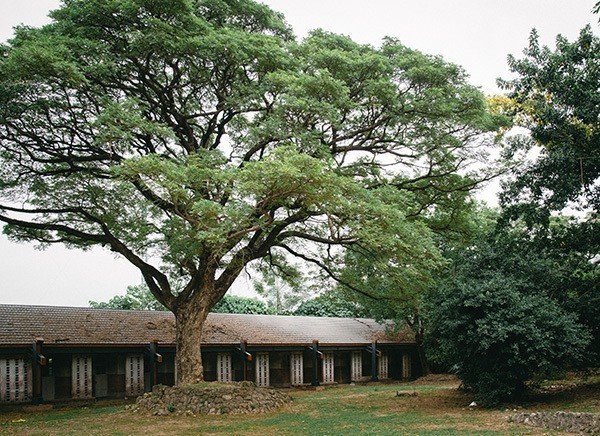Ciaotou Sugar Refinery is inarguably Ciaotou District's most popular tourist destination. It is also very accessible for travelers, since the Kaohsiung Rapid Transit has a stop right in front of the refinery. There are also other sightseeing spots nearby. So, come and experience the region's unique history. Ciaotou Sugar Refinery was built during Japanese colonial rule period and was the first modern sugar refinery in Taiwan. It was established by the Japanese company Mitsui Corporation, with operations commencing in 1902. At the height of its yearly production it contributed 60,000 metric tons of sugar. Ciaotou became a prosperous industrial area because of it. The once flourishing sugar refinery closed in 1999, yet it will always be an important part Ciaotou's sweet history. Local agricultural industries continue to flourish in the Ciaotou District, with a variety of products, including dairy farming, honey and flowers. Today, Ciaotou Sugar Refinery is now a visitor park that educates visitors on this once important industry. It exhibits the refinery's history, operations and architecture. The former factory and office buildings were transformed into the Sugar Refinery Museum, with a surrounding recreational park.  Visitors can gain knowledge about how sugar cane was transformed into sugar during the Japanese colonial rule period. The Sugar Refinery Museum exhibits its old machinery and relates stories about the refinery back in its heyday. There is also a century-old rain tree and behind it is the Bywood Art Space, which was previously a Japanese guest house. Here, visitors can participate in various workshops, including plant dying, paper making and tree climbing. The old trains, railway and other art installations are also on display in and around the museum. There are also two well-preserved Japanese colonial-era buildings, including the baroque-style Mitsui Corporation office and the director's wooden dormitory. The Mitsui office was the first concrete and steel building in Taiwan. Visitors can also see the refinery's guardian deity, a black Guanyin statue that has been situated in front of the Mitsui Corporation office since it was established in 1902. It was designed to represent the Guanyin at Yakusi-ji Temple in Nara, Japan, and was intended to make the Japanese workers feel more at home, while bridging the cultural gap between the company and local farmers. Last year, the elegant buildings gained nationwide popularity due to the 2017 Golden Horse Award winning Taiwanese film called, The Bold, The Corrupt and The Beautiful. The movie was set in the two buildings. ◎Other nearby Attractions During the weekends, there is also a small train to shuttle passengers between the Ciaotou MRT Station, the sugar refinary and the Kaohsiung Flower & Farm Recreational Park. This park also belongs to Taiwan Sugar Corporation and is situated adjacent to Ciaotou Sugar Refinery. It offers visitors the opportunity to cook with a traditional earthen kiln and is popular with families on the weekends. At the Ciaotou MRT Station, visitors can see prestigious Meinong artist Dr. Chu Pan-hsiung's gigantic public art mural called, "Heavenly Creations". Located on the wall at Exit 2, it is made up of 1311 ceramic pieces and is 9 meters in width and 12 meters in height. Dr. Chu explains the mural depicts the Ciaotou Sugar Refinery, its railway and how it contributed to Taiwan's industrial development. The top and bottom of the mural depict the earth, and the middle depicts clouds, which is symbolic of the civility of the city. Travelers should also explore the Cingpu MRT Station and the adjacent Rainbow Bridge. The bridge is particularly charming when it is lit up at night. There is also a Ciaotou Equestrian Center, where locals come to learn how to ride. Besides taking in the area's historical sites, it is also a place that also features arts and culture. Last October, the Bais Cultural & Educational Group CO. Ltd. and Ten-Drum Percussion Group came together to create the Bais New World Recreational Center, which is located inside the refinery. Here visitors can experience VR games or watch cultural shows in its performance space. During the weekends, Ten-Drum also puts on thirty minutes performances which can be seen at 10:30 am and 3 pm. Cultural travelers can also go to Silin Sanhe Yuan, on Linsi Road, where they can see a traditional residential compound. It was recently renovated by local residents, who also added an adjacent garden. In 2016, its distinct architecture won the Yuan Ye Distinct Architecture Award, which was presented to them by Kaohsiung's Creative Architecture Association. Visitors should also go to Ciaotou Old Street. This is the village's main road and is where locals meet to shop and eat. Here travelers can meet locals and observe how they live. Some of the local delicacies include, Grandma's Tuna Curry, Huang's Braised Ground Pork Rice and Wulilin Steamed Pork Baozi. Grandma's Tuna Curry has been in operation for 70 years and specializes in curries and rice noodle dishes. Huang's Braised Ground Pork Rice is made from pork shoulder and belly and was honored with first prize in an online gourmet competition. There is also the Wulilin Steamed Pork Baozi with delicious fillings. If visitors want to sample some of these popular dishes, ask a local to show them where to go. | 

沒有留言:
張貼留言